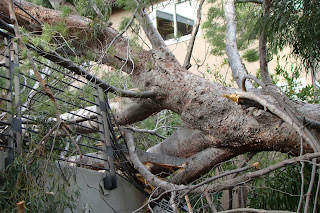
That’s what the last rains brought us - kinda. Mount Wilson received a nice light sprinkle of white and made us remember that we can have everything here after all- Snow and surf. Mount Baldy (or Mount San Antonio to be correct) has had snow for some time now and is mostly hidden behind the clouds.
We also made some progress with the cleanup after the storm- after the tree crew was done chopping down the huge trunk (firewood for years to come) the full amount of the damage became obvious. The worst for us, though, is the landscaping. The area where the tree hit was our most beautiful spot- and now it looks like a plane went through. Some of the palms may recover, but some got hit really hard and I can only hope, that they will survive and heal in time.
One look at the bright side- we now have an extended view towards the Northwest and see the Verdugo Hills and Mount Lukens now.




























